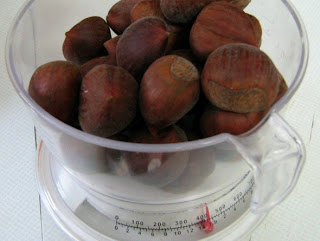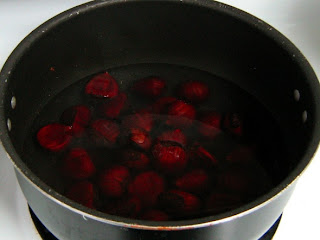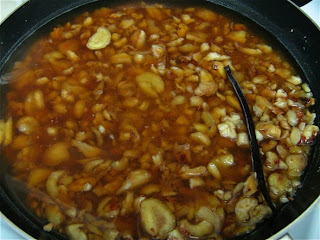
When I moved to Toronto from Newfoundland, one thing I couldn’t take were all my mother’s cookbooks from which I’d been cooking for a few years. It’s part of moving out, I know, to start a collection of your own, but there’s something beautiful about a book that you and your family have been using for years. The pages are a little worn, there are stains on the pages from fingers and from chocolate (or tomato, or fennel, as I discovered in my Indian cookbook this morning), and you’ve adjusted measurements to suit your tastes. Your experiences and memories are recorded in that book.
So starting over is hard and my collection in Montreal is still relatively small. Most of the books I have I don’t even use – leftovers from when I started that my mother could bear to part with (Kids Cooking, 1001 low-fat recipes, mostly junk, really, but great ways to get started before I turned into a snob. If anyone reading this wants to make a pot of dirt and worms – chocolate soil and gummy worms – let me know and the book’s all yours).
The one precious book my mother did let me take was Alice Medrich’s “Chocolate and the Art of the Low-Fat Desserts”. It is the most sublime dessert book. It has recipes that range from easy to very, very difficult and I’ve worked my way up from chocolate icebox cookies to meringues, to grand marnier cakes, to frozen hazelnut tortes made of multiple mousses (often unsuccessfully, but sometimes with a little bit of air-filled luck). Alice taught me the wonders of pillowy lemon mousse (yes, in a chocolate cookbook), the simplicity of custard, the beauty of genoise, and the wonders of properly made buttermilk loaves (oh, and liquor soaks. God I love liquor soaks). It’s such a good book that even though it’s out of print, my mother found a used copy online just so I wouldn’t have to cart mine home every Christmas and waste valuable suitcase space (traditionally, half the baggage on a St. John’s final destination Christmas flight doesn’t make it anyway because so many people are going home with some many things for family who they haven’t seen in a year that the air carrier just doesn’t load about half the baggage because they assume there will be weight problems on the sardine-stuffed plane. The baggage, not just the people).
The point of all this nostalgia is that she (Alice, not my mom) has two recipes that use chestnut purée. Working my way through the book I wanted to make these recipes, especially since she describes it as a simple delicacy, to be enjoyed on its own as a light dessert. In Parisian bistros waiters would serve it to you directly from the can with a little creme fraiche. In fact, the only places I’ve seen the purée (which can be bought sweetened or unsweetened, or whole in syrup) are in gourmet specialty stores and the only brands for these cans that I’ve seen are still imported from France.
Turns out that chestnut trees in North America pretty much died out! Chestnut purée was never big here like in France so no one seemed to miss them, but you can still find fresh chestnuts around Thanksgiving, and more often toward Christmas (chestnuts roasting on an open fire and all that, but who has actually roasted a chestnut? Maybe you would have if there had been more trees). They’re making a come-back, though. The native North American variety is being combined with the Asian variety for a chestnut resistant to the blight that plagued the N.A.-version. Apparently, in 10-15 years we’ll have a genetically modified chestnut that’s 15/16th North American and 1/16th Asian. I’m not sure how I feel about the genetic modification…Anyway, look for the Italian or French chestnuts if you can find them, instead of the Asians, says my chestnut source.
The cooking process is time and labour-intensive, so I still recommend buying the relatively expensive purée (though the fresh chestnuts aren’t exactly cheap either), unless you’re me, of course, or want to experience it once, or…well, you know that home-made is always better.
There are a few methods to making chestnut purée. If you’re going to roast them you need to score them with a knife first (an ‘X’ on the bottom) so they don’t explode in the oven. The easier way is to boil them twice to remove the two layers of skin, and it doesn’t effect the flavour too much if you’re making purée from it.
Vanilla Bean Chestnut Purée
1 kg fresh chestnuts
500g (2 cups approximately) sugar
1 litre (about 4 cups) of water
A vanilla bean (optional, but a VERY, VERY good idea. Or you can add a 1/2 tsp of vanilla extract near the end)
Salt
Put the whole chestnuts in a pan of cold water and bring to a boil. Boil for 3 minutes. (In theory you can now remove the outer layer of skin, but the recipe was ambiguous about this, so I just left it on).
Drain and place them back in the pan with some fresh water, this time with a pinch of salt, and boil them for about 20 minutes. Leave the chestnuts to stand in the water (take the pot off the heat) for an extra 5 minutes.

Remove them from the pan a few at a time (put the lid back on after removing each couple to keep the heat in, since they’re harder to remove when they’re too cool) and carefully remove the chestnut skins (cut in with a knife to open the chestnuts like a books and scoop out the flesh with a spoon).
Place the chestnuts in a shallow frying pan.
Dissolve the sugar and water in a separate pot over low heat. Add the vanilla bean and allow to simmer while gently stirring until the syrup thickens a little. If you’re using extract, allow the syrup to thicken and then add 1/2 tsp extract.

Pour the syrup over the chestnuts and simmer gently on low for about 30 minutes. Turn the heat off and let them steep in the pan for 20 minutes. Place in blender or food processor and purée, or just serve these are half chestnuts in their syrup. I could have puréed the chestnuts after removing them from their skins, but then they’ll burn more easily in the frying pan.
Serve with crème fraiche, thick yogurt, or whipped cream (I personally think ice cream is too cold to serve with the chestnuts. The chestnut flavour would be hidden and you definitely wouldn’t taste any vanilla. The lighter creme fraiche contrasts the sweetness of the chestnuts (mostly carbohydrates) and lets the vanilla shine through. In theory a vanilla yogurt or ice cream would complement the vanilla of the purée but all that fake vanilla flavouring feels wrong after using a real, luxurious vanilla bean (maybe a home-made yogurt made with the same kind of vanilla bean. If I had an ice cream maker I’d still give it a try, even though I think it would be too cold).
It’s the simple things in life…
Leave a Reply